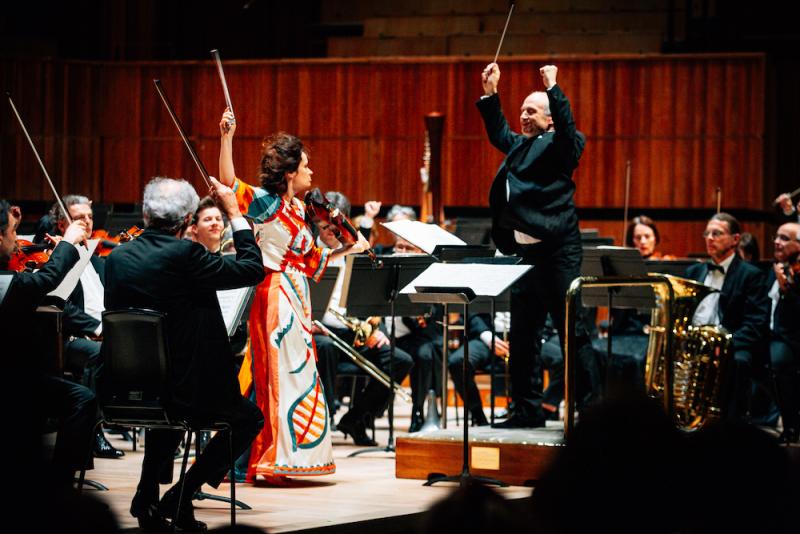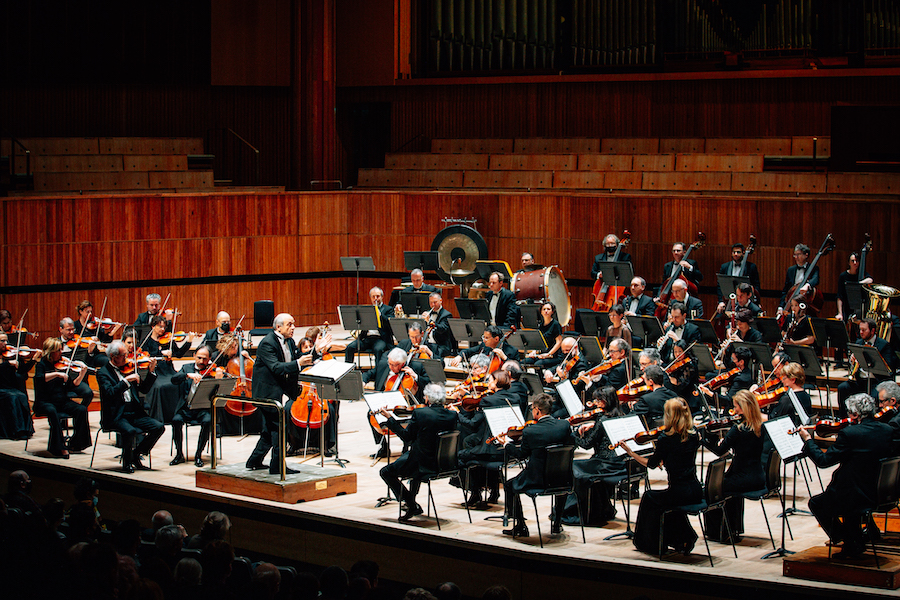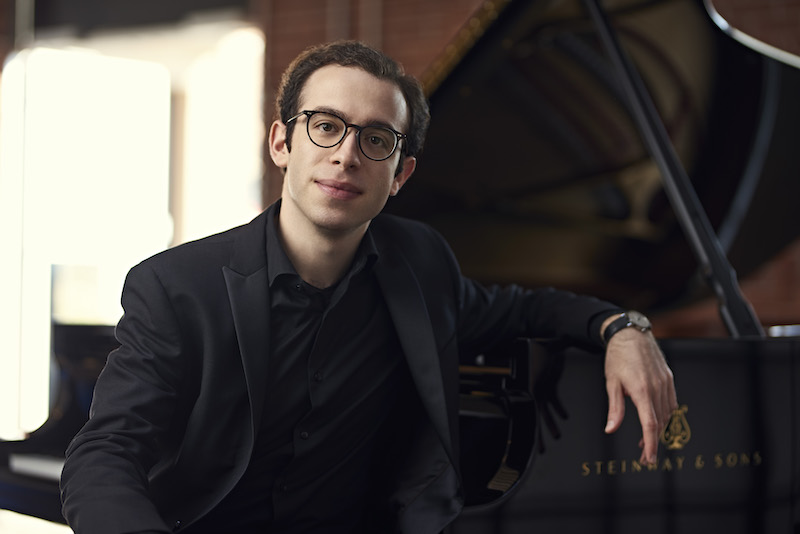Kopatchinskaja, Namoradze, Budapest Festival Orchestra, Fischer, RFH review – a Stravinsky feast | reviews, news & interviews
Kopatchinskaja, Namoradze, Budapest Festival Orchestra, Fischer, RFH review – a Stravinsky feast
Kopatchinskaja, Namoradze, Budapest Festival Orchestra, Fischer, RFH review – a Stravinsky feast
Contrasting concertos, a thrilling Rite – and a spine-tingling finale

It might seem odd to start with the encore, but I’ve never seen one like it. At the end of its two-night residency at the Festival Hall, having just romped through the rigours of The Rite of Spring, the players of the Budapest Festival Orchestra put their instruments down, shuffled to their feet and sang for us.
The two all-Stravinsky programmes that the orchestra offered – the Friday night audience depleted by storm Eunice – followed the same structure: an orchestral opener followed by a concerto and rounded off with one of the great ballets. The sizzling Rite of Spring was the highlight, but the concertos were both very satisfying performances.
Patricia Kopatchinskaja threw down the opening chords of the Violin Concerto pugnaciously, like she was challenging the audience to a fight. Her punky, combative approach propelled the first movement forward with a pleasing devilishness, but at time risked being pantomimic. But in the middle movements, a pair of arias, Kopatchinskaja found a beautiful cantabile, sensitively accompanied by a deceptively large orchestra. Iván Fischer used some eccentric seating plans on both nights, most notably in the ViolinCconcerto, where the front row of strings was replaced by the low brass. I have never seen a tuba sitting where the principal second violin should be, but it made sense of some of Stravinsky’s oompah textures and the tubist, Jószef Bazsinka, was terrific throughout.
Iván Fischer used some eccentric seating plans on both nights, most notably in the ViolinCconcerto, where the front row of strings was replaced by the low brass. I have never seen a tuba sitting where the principal second violin should be, but it made sense of some of Stravinsky’s oompah textures and the tubist, Jószef Bazsinka, was terrific throughout.
Fischer’s conducting, which is always watchable, at times almost slips into micromanagement. He was more understated in the concertos than elsewhere, and fantastic in the last movement, which threw caution to the winds and was genuinely exciting in its edge of danger.
The concerto on Friday was the Capriccio, a work for piano and orchestra from 1929 that Stravinsky wrote for himself. It is not therefore the most demanding solo part, but requires characterisation and swift changes of tone. I was really taken with the playing of Nicolas Namoradze (pictured below by Nathan Elson), who is a bit of a dude, from his green shoes upward. His playing was precise and cool and very Stravinskian, technically effortless. Stravinsky’s writing is witty, with everything in quotation marks, and Namoradze got that, conjuring the references from Tchaikovsky to Ravel with understated ease. Petrushka, which ended the Thursday concert, was very good, if not electrifying. Fischer here cast himself as the ringmaster – belying his general demeanour of a genial maître d’ – leading the parade of characters at the Shrovetide Fair. The multi-layered orchestration was delightful, with some wonderful wind playing from clarinettist Ákos Ács and buoyant bassoonist Bence Bogányi, who was also fantastic in the famous Rite opening. There were a couple of moments of problematic coordination and a couple of brass fluffs, but in this regard we are spoiled by being used to perfect recordings and these moments are a small price to pay for hearing such an orchestra in full flow.
Petrushka, which ended the Thursday concert, was very good, if not electrifying. Fischer here cast himself as the ringmaster – belying his general demeanour of a genial maître d’ – leading the parade of characters at the Shrovetide Fair. The multi-layered orchestration was delightful, with some wonderful wind playing from clarinettist Ákos Ács and buoyant bassoonist Bence Bogányi, who was also fantastic in the famous Rite opening. There were a couple of moments of problematic coordination and a couple of brass fluffs, but in this regard we are spoiled by being used to perfect recordings and these moments are a small price to pay for hearing such an orchestra in full flow.
Jeu de Cartes, the Thursday opener, was surprisingly sluggish at first, and perhaps lacked a sense of fun, until the ending, one of Stravinsky’s best. Likewise the Concerto in D on Friday didn’t quite have the sharpness of attack it really needs – I was surprised the violin and double bass contingent wasn’t reduced for this as it felt just too full-bodied for what is really a concerto grosso.
But there were no such reservations about The Rite of Spring. Since this is an absolute favourite of mine I am predisposed to enjoy it – but also perhaps predisposed to be disappointed. No danger of that here. From the teeming winds of the Introduction to the violent end, everything was as it should be. Fischer, conducting from memory and almost throwing himself off the podium at one point, found some new things in the score – I particularly liked his slightly prolonging the bassoons in the final chord of Part 1. The strings were rich and dark in the “Spring Rounds” and the ensemble throughout as tight as handcuffs. The “Sacrificial Dance” had some eccentric tempo changes but built to a fine frenzy – before the brilliant final gesture of the orchestra as choir, faithfully following their leader to the most unlikely of destinations.
rating
Explore topics
Share this article
Add comment
The future of Arts Journalism
You can stop theartsdesk.com closing!
We urgently need financing to survive. Our fundraising drive has thus far raised £49,000 but we need to reach £100,000 or we will be forced to close. Please contribute here: https://gofund.me/c3f6033d
And if you can forward this information to anyone who might assist, we’d be grateful.

Subscribe to theartsdesk.com
Thank you for continuing to read our work on theartsdesk.com. For unlimited access to every article in its entirety, including our archive of more than 15,000 pieces, we're asking for £5 per month or £40 per year. We feel it's a very good deal, and hope you do too.
To take a subscription now simply click here.
And if you're looking for that extra gift for a friend or family member, why not treat them to a theartsdesk.com gift subscription?
more Classical music
 Hallé John Adams festival, Bridgewater Hall / RNCM, Manchester review - standing ovations for today's music
From 1980 to 2025 with the West Coast’s pied piper and his eager following
Hallé John Adams festival, Bridgewater Hall / RNCM, Manchester review - standing ovations for today's music
From 1980 to 2025 with the West Coast’s pied piper and his eager following
 Kaploukhii, Greenwich Chamber Orchestra, Cutts, St James's Piccadilly review - promising young pianist
A robust and assertive Beethoven concerto suggests a player to follow
Kaploukhii, Greenwich Chamber Orchestra, Cutts, St James's Piccadilly review - promising young pianist
A robust and assertive Beethoven concerto suggests a player to follow
 Robin Holloway: Music's Odyssey review - lessons in composition
Broad and idiosyncratic survey of classical music is insightful but slightly indigestible
Robin Holloway: Music's Odyssey review - lessons in composition
Broad and idiosyncratic survey of classical music is insightful but slightly indigestible
 Classical CDs: Wolf-pelts, clowns and social realism
British ballet scores, 19th century cello works and contemporary piano etudes
Classical CDs: Wolf-pelts, clowns and social realism
British ballet scores, 19th century cello works and contemporary piano etudes
 Bizet in 150th anniversary year: rich and rare French offerings from Palazzetto Bru Zane
Specialists in French romantic music unveil a treasure trove both live and on disc
Bizet in 150th anniversary year: rich and rare French offerings from Palazzetto Bru Zane
Specialists in French romantic music unveil a treasure trove both live and on disc
 Scottish Chamber Orchestra, Ibragimova, Queen’s Hall, Edinburgh review - rarities, novelties and drumrolls
A pity the SCO didn't pick a better showcase for a shining guest artist
Scottish Chamber Orchestra, Ibragimova, Queen’s Hall, Edinburgh review - rarities, novelties and drumrolls
A pity the SCO didn't pick a better showcase for a shining guest artist
 Kilsby, Parkes, Sinfonia of London, Wilson, Barbican review - string things zing and sing in expert hands
British masterpieces for strings plus other-worldly tenor and horn - and a muscular rarity
Kilsby, Parkes, Sinfonia of London, Wilson, Barbican review - string things zing and sing in expert hands
British masterpieces for strings plus other-worldly tenor and horn - and a muscular rarity
 From Historical to Hip-Hop, Classically Black Music Festival, Kings Place review - a cluster of impressive stars for the future
From quasi-Mozartian elegance to the gritty humour of a kitchen inspection
From Historical to Hip-Hop, Classically Black Music Festival, Kings Place review - a cluster of impressive stars for the future
From quasi-Mozartian elegance to the gritty humour of a kitchen inspection
 Shibe, LSO, Adès, Barbican review - gaudy and glorious new music alongside serene Sibelius
Adès’s passion makes persuasive case for the music he loves, both new and old
Shibe, LSO, Adès, Barbican review - gaudy and glorious new music alongside serene Sibelius
Adès’s passion makes persuasive case for the music he loves, both new and old
 Anja Mittermüller, Richard Fu, Wigmore Hall review - a glorious hall debut
The Austrian mezzo shines - at the age of 22
Anja Mittermüller, Richard Fu, Wigmore Hall review - a glorious hall debut
The Austrian mezzo shines - at the age of 22
 First Person: clarinettist Oliver Pashley on the new horizons of The Hermes Experiment's latest album
Compositions by members of this unusual quartet feature for the first time
First Person: clarinettist Oliver Pashley on the new horizons of The Hermes Experiment's latest album
Compositions by members of this unusual quartet feature for the first time

Comments
Bernard mentions Nicolas
Boom boom tish...